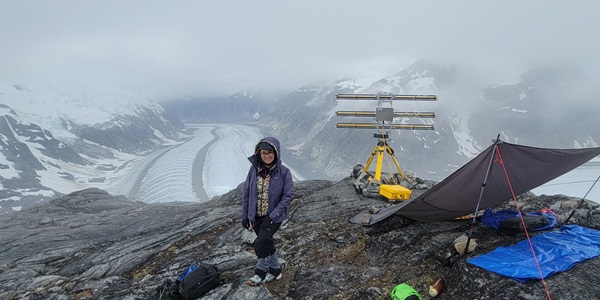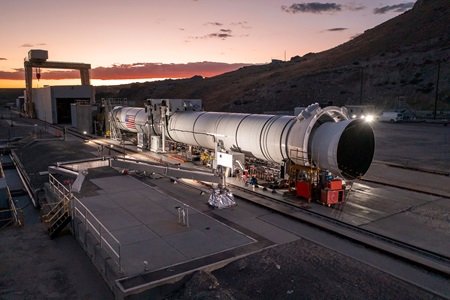Northrop Grumman engineer and mission architect, Krystal called an arctic research site in Juneau, Alaska, home for three weeks.
Designing a Railroad on the Moon
Envisioning the Future of Lunar Transportation
By Michelle A. Monroe
When the U.S. government asked for new ideas for the moon’s future, a Northrop Grumman engineer answered: How about a railroad?
Spencer Levin, now a principal investigator for the Lunar Rail Network at Northop Grumman, considered the critical forms of infrastructure on Earth, and railroads came to mind because of their significant contributions to human civilization.
“Railways are essential for facilitating the movement of commercial ventures on Earth. So why not the moon?” Spencer said.
On previous moon missions, astronauts packed everything they needed for lunar exploration — from rovers and power equipment to communications instruments. Then, after completing their mission, they abandoned many of these supplies on the moon and returned home. This isn’t a very effective way to travel, said Steven Floyd, Northrop Grumman’s chief engineer of additive manufacturing and program manager for the Lunar Rail Network.
“Imagine many people driving their cars to an airport, then getting on a plane and never returning for their vehicles,” Steven said, equating this scenario to lunar transportation. “The current approach would litter the moon with stranded space vehicles, with no effective means of returning them to Earth, creating a lunar junkyard.”
Envisioning the Future
The moon is a gateway to Mars and beyond, so having an efficient transportation infrastructure on the lunar surface will be crucial to support the influx of space vehicles for scientific and commercial missions. In August 2023, The Defense Advanced Research Projects Agency (DARPA) requested ideas for a 10-Year Lunar Architecture Capability Study to explore lunar infrastructure that could support a sustainable commercial economy.
DARPA selected more than a dozen companies to pursue infrastructure studies — including examining landing, power, communications and robotics on the moon — and they chose Northrop Grumman to investigate its proposal for a lunar rail network. We delivered our study to DARPA in June 2024, offering a comprehensive blueprint for the future.
“It’s all conceptual, but we’re leveraging prior studies and working with partners like the Colorado School of Mines,” Steven said. “Under our concept, the railroad would be entirely built by robots.”
Construction would involve robotic vehicles such as excavators that prepare the surface and assemblers that put the pieces of track together. The final product would integrate rail vehicles — including flatbeds, tankers, and hoppers — designed to efficiently transport payloads across the lunar terrain.
“As the infrastructure of the moon builds out, officials may use this study and others to chart the path of the future,” Steven said. “This is the equivalent of city planning but on the moon. This could shape the future of what the moon looks like. We’re excited Northrop Grumman is at the forefront of these discussions.”
The study has generated conversation across the industry.
Speaking about the program at the Lunar Surface Innovation Consortium, Dr. Michael Nayak, LunA-10 program manager at DARPA, said, “Logistics is the lifeblood of any economy, and this concept filled a big hole we felt no one was thinking about. For taking logistics from the point of delivery to the point of need, a lunar rail makes a lot of sense once you’ve reached a critical growth stage in the lunar economy.”
On The Right Track
A lunar rail network could access remote areas, including the permanently shadowed regions near the south pole, which may contain water, ice and mineral deposits, without kicking up dust like rovers, Steven said. The study looked at initial distances of up to 40 kilometers linking multiple sites, but eventually distances hundreds of kilometers away could be connected. It would link key locations such as scientific outposts, landing sites, and mines where local resources could be harvested for construction rather than launching supplies from Earth.
“We developed an integrated system concept design, using our expertise in technologies like in-space servicing robotics and autonomy, advanced power collection systems, rovers, and spacecraft subsystems,” Steven said. “We set out to understand all pillars of building and operating a lunar railroad system: the construction, the tracks, the station infrastructure, the actual vehicles that will traverse the route.”
They also analyzed potential challenges — such as uncertainties in lunar soil composition and extreme temperatures around -200 Celsius — and provided plausible solutions that tie together into a system concept that could be beneficial for future lunar work.
“Northrop Grumman has consistently been a pioneer of expanding our understanding of the solar system and beyond,” Steven said. “We’re leading the way in pioneering new ways of using space and the moon is the next step in that journey. We are expanding the way humans use things beyond Earth.”
Carri Karuhn contributed to this article.
Learn more about our civil and commercial space capabilities and programs, and if you’re interested in defining possible with us, explore what life’s like at Northrop Grumman.


